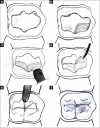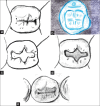Incremental techniques in direct composite restoration
- PMID: 29430088
- PMCID: PMC5799982
- DOI: 10.4103/JCD.JCD_157_16
Incremental techniques in direct composite restoration
Abstract
Polymerization shrinkage is one of the dental clinician's main entanglements when placing resin-based composite restorations. None of the method can assure a perfectly sealed restoration for adhesive restorative materials; clinicians must abode problems of polymerization shrinkage and its possible ill effects. The objective of this article is to review different incremental techniques that can ruin the polymerization shrinkage stress of direct composite restoration.
Keywords: Composites; incremental techniques; layering techniques; polymerization shrinkage.
Conflict of interest statement
There are no conflicts of interest.
Figures











References
-
- Osborne JW, Norman RD, Gale EN. A 12-year clinical evaluation of two composite resins. Quintessence Int. 1990;21:111–4. - PubMed
-
- Hickel R, Manhart J. Longevity of restorations in posterior teeth and reasons for failure. J Adhes Dent. 2001;3:45–64. - PubMed
-
- Manhart J, Chen H, Hamm G, Hickel R. Buonocore Memorial Lecture. Review of the clinical survival of direct and indirect restorations in posterior teeth of the permanent dentition. Oper Dent. 2004;29:481–508. - PubMed
-
- Macedo G, Raj V, Ritter AV. Longevity of anterior composite restorations. J Esthet Restor Dent. 2006;18:310–1. - PubMed
-
- Zachrisson BU, Mjör IA. Remodeling of teeth by grinding. Am J Orthod. 1975;68:545–53. - PubMed
Publication types
LinkOut - more resources
Full Text Sources
Other Literature Sources
Medical

